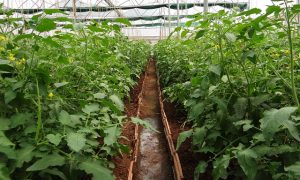
Hello! My brother decided for the first time in his life to make himself a greenhouse. He constantly wanted to have fresh vegetables on hand.
Over time, he learned more and more nuances associated with the greenhouse, and not all of them were pleasant.
One brother called me in frustrated feelings: almost all of his cabbage was worn out. As it turned out, the whitefly was to blame. She shared with her brother her experience in dealing with this pest. Want to learn how to deal with whiteflies in a greenhouse? In the article below I will analyze in detail the effective methods.
The content of the article:
- 1 Whitefly in a greenhouse - prerequisites and methods of struggle
- 2 In a greenhouse, a whitefly is very harmful. How to get rid of it?
- 3 How to deal with folk, chemical means
- 4 Protecting greenhouse plants from whiteflies
- 5 What is an insect?
- 6 How to get rid of whiteflies in a greenhouse
- 7 Methods of controlling whitefly in a greenhouse and indoor plants
- 8 Whitefly - an uninvited guest in a greenhouse
Whitefly in a greenhouse - prerequisites and methods of struggle
On the one hand, in greenhouses it is easier to create the conditions necessary for plants, but on the other hand, various pests that enter it from outside multiply faster in enclosed spaces. One of them is the greenhouse whitefly.
It is even better not to allow the appearance of this pest in the greenhouse at all, and for this you need to know about prevention methods.
Why is she dangerous
This insect began its destructive procession in the gardens and kitchen gardens of the European part of Russia at the end of the 19th century, destroying primarily vegetable crops such as tomatoes, eggplant, cucumbers, celery, parsley.
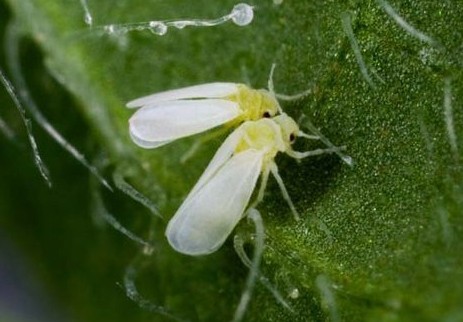
The danger to them is not only moth larvae sucking juices from plants, but also their secretions, which are a breeding ground for soot fungus, and adult insects themselves - carriers of viral diseases.
Therefore, the fight against whiteflies in the greenhouse is very important. But for this pest to be recognized.
Pest Description
An adult insect is a small moth with white wings and a pale yellow body. Females are slightly larger than males - the latter reach a size of 0.9 mm.
First, antennae and legs can be distinguished on them, but, having sucked to the leaf, the larva is freed from the legs. During this period, it looks like a motionless flat shiny flake on the surface of the sheet.
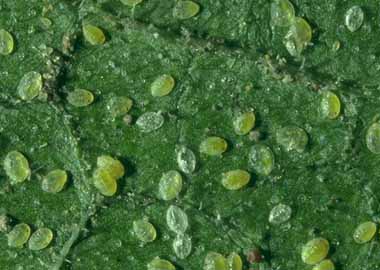
Having reached the stage of the nymph in its development, the larva acquires a greenish color, a wax coating appears on its body, and red eyes become distinguishable.
Throughout the entire period of development from the larva to the adult (adult insect), the whitefly feeds on amino acids contained in the sap of plants, thereby depriving them of vitality.
It turns out that this small insect attacks plants immediately on three fronts, which means that the question of how to destroy the whitefly in the greenhouse literally becomes a matter of life and death for your green pets.
Nature of lesions
You can determine the presence of intruders by the many white dots on the underside of the leaves, as well as by a brilliant coating with dark spots. Very soon, due to the nutritional activity of the larvae, the leaves begin to deform and dry out, new leaves become smaller, the buds die, and the fruits do not set.
If no whitefly control measures are taken in the greenhouse, the plants will begin to lack nutrients and die. But danger lies in wait on the other hand.
A sooty fungus that settles on the secretions of the larvae covers the surface of the leaf and interferes with normal photosynthesis and respiration. The situation is exacerbated by the occurrence of infectious diseases, the causative agents of which are carried by adult males and female whiteflies.
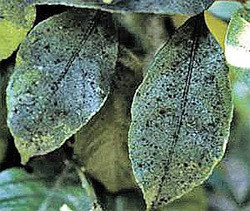
So, the signs of the appearance and reproduction of pests are as follows:
- Shiny or white spot coating on the leaves;
- Deformation of leaves and young shoots;
- Curl of leaves;
- Chlorosis or yellow mosaic on them;
- At a late stage - necrosis of the fruit.
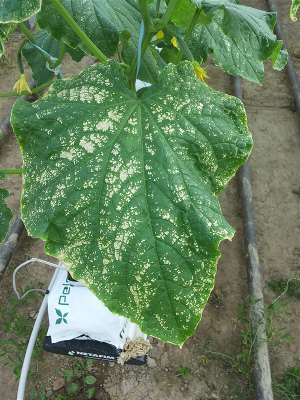
These symptoms should be a signal that urgent struggle in the greenhouse with the whitefly is necessary.
Methods of prevention and destruction
In order not to have to decide how to get rid of the whitefly in the greenhouse, you need to try not to let it go by taking preventive measures. This is not so difficult to do, because in our harsh climatic conditions this insect cannot winter and, therefore, cannot get into shelter just from the street.
The most common reason for its appearance is the relocation from one greenhouse or greenhouse to another along with planting material. Whitefly can sometimes start in seedlings grown in the apartment, so any plants that you plan to plant must be carefully inspected before they even get into shelter.
If you bought a summer cottage, which already has a greenhouse, do not rush to immediately put it into operation. Make sure it is equipped with ventilation vents and treat all structures with pesticides. Before processing the greenhouse from whiteflies, thoroughly wash it.
In the process of growing vegetables with your own hands, try to comply with agricultural technology: maintain the right temperature in the greenhouse, ventilate the shelter on time, prevent excess moisture and thicken plantings, etc. Compliance with these rules can also be considered preventive measures that prevent the appearance of not only whiteflies, but also many other pests and diseases.
Chemicals
The most effective against whitefly are modern chemical and biological agents, among which the most popular are Inta-Vir, Iskra, Fufanon, Actellik and other drugs.
As a rule, it should not exceed 0.05-0.08%, but it is better to act according to the instructions of the manufacturer - instructions for dosage and methods of use are attached to each drug.
Whitefly is able to quickly adapt to chemicals, so when it reappears or when the result is unsatisfactory, the methods of control must be changed, alternating the preparations and not using previously used ones.
We give brief recommendations on the consumption and frequency of application of some of the most effective means:
- Confidor - 0.1 ml per 1 liter of water. It is applied once during the season.
- Fufanol - 1.2-1.5 ml per 1 liter of water. It is applied once.
- Mospilan - 0.05-0.06 g per 1 liter of water. Also intended for single use.
- Pegasus - 2 ml per 1 liter of water. It is used for double spraying with a frequency of 7-10 days.
- Verticillin - the method of use is similar to Pegasus, but the consumption is much higher - up to 25 ml per 1 liter of water.
- Actellicus plants can be treated 3-4 times, but it is effective only at the stage of emergence of whiteflies. Dosage - one ampoule per 1 liter of water. The solution is enough for 5 m2.
Folk ways of struggle
If you could not find the necessary drugs on sale or you are not satisfied with their price, you can also control pests with folk remedies:
Planting in the greenhouse of umbrella plants - dill or ghoul.. They attract other insects - riders and ticks, which are the main enemies of whiteflies. They lay their larvae directly in the larvae of this pest.
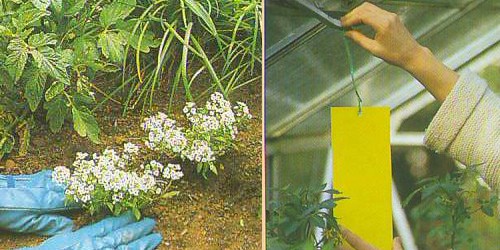
Smoke bombs.. One of the most effective ways to destroy a whitefly in a greenhouse. If after processing to prevent violations of the temperature and humidity conditions, insects will not appear in it for a very long time.
But remember that the main preventive measure is attentive care of the plantings, their garter and thinning, good ventilation and compliance with the temperature regime.
In a greenhouse, a whitefly is very harmful. How to get rid of it?
This small insect spoiled the nerves of many gardeners and growers. If a whitefly appeared in the greenhouse and it was not possible to get rid of it on time, all plantings may die. How to deal with this scourge?
The enemy must know in person
To combat whitefly, it is important to recognize its appearance in the greenhouse in time. The whitefly pest is a small leaf-sucking insect resembling a moth, only smaller (about 2 mm).
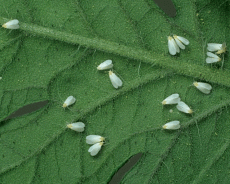
Whiteflies usually settle in colonies on the bottom of leaves of tomatoes, peppers, cucumbers, and eggplant. It can be detected by indirect signs (yellowing and spots on the leaves or by touching the plant ("butterflies" instantly take off, moving to neighboring bushes).
A bit of history
Hothouse whitefly appeared in the CIS relatively recently, in the early 80s of the last century: then flowers, including in pots, were actively brought to us from abroad. She came with them.
The reason is banal: elementary phytosanitary rules were not respected. From professional greenhouses, the pest moved to private, and later on indoor plants and in open ground.
There are species of whiteflies that live in the open ground on vegetable crops, on strawberries, cabbage, and ornamental plants. And since winters have been mild in recent years and summers are hot, whiteflies have become very numerous.
How to deal with it
Whitefly, sucking all the juices from young shoots, can destroy the gardener's labor in a few days, leaving it without a crop. Unfortunately, among insecticides permitted in LPH, there are few effective against whiteflies.
Prevention among methods of controlling whitefly plays an important role. There are a number of measures that can minimize the likelihood of a pest occurring to a minimum:
- The soil intended for the preparation of seedlings must be well frozen and steamed before use.
- Before planting, purchased plants must be quarantined (in a separate greenhouse or fenced off from the rest of the plantings with a plastic screen: the insect travels with planting material).
If it was not possible to prevent the appearance of whiteflies in the greenhouse and it has already settled on the site, it is important to reduce its number. To do this, carefully clean the greenhouse from plant debris in the fall.
Fold them in plastic trash bags, pouring with ash and urea, pour boiling water, tie and soak, so that the mass lasts two to three weeks. If the greens are immediately put into the composter, the pest in it will safely winter.
Dig the rest of the soil, leaving lumps to freeze the ground. Around the greenhouse and the garden, do not forget to carefully weed out the weeds, especially the rot, which the whitefly just adores.
If the greenhouse is heated and operated in the winter, sow salad, leaf mustard (not for food), and sprout seedlings with a solution of Aktara. In addition, specially for catching whiteflies, yellow glue traps can be hung over the beds.
With a very high pest abundance, purchase dry preparations or live predatory entomophages — enkarsia and trichaporus — in a specialized store or at a plant protection station.
In the spring, having found the pest site, sprinkle the plantings with one of the preparations: Fosbetsid, Actellik, Fitoverm. They help in the fight against whitefly well.
Folk remedies
With single individuals, whiteflies can be dealt with folk remedies, for example, garlic nastoyem. It is prepared as follows:
- chop 150 g cloves of garlic;
- add 1 liter of water;
- insist in a dark bowl for a week.
Before spraying, the garlic infusion must be diluted 10 times, since excessive concentration can damage the plants.
Still to get rid of whiteflies in the greenhouse with folk remedies, dandelion infusion is used: 100 grams of chopped roots and leaves pour 1 liter of heated water and stand for 4-5 hours. This infusion can not be bred.
Treatment of plants from whiteflies by such means should be carried out once a week and a half. After spraying, the surface of the beds is sprinkled with ashes.
How to deal with folk, chemical means
Fighting whiteflies in a greenhouse in tomatoes is a fairly urgent problem. Whitefly is a dangerous plant pest. Small flying insects are similar to white moths, which swarm soar above a disturbed plant.
On the leaves of tomatoes, you can find insect eggs and their larvae, represented by small grayish grains. It is worthwhile to figure out how to deal with such a pest.
The easiest ways
Bushes of tomatoes can be treated with a stream of clean water. Small insects are flushed with water from a hose.
In addition, before treating the plant with any means, peeling of tomato leaves from plaque and adults is required.Processing is carried out no more than twice during the week until the pest disappears completely.
Special traps
First of all, it should be noted that the struggle begins already in the greenhouse. In addition, you need to wash all damaged plants with a soap solution, thereby removing the larvae.
To begin with, special traps with adhesive agents are suitable. Today they are freely available in markets or in specialized stores. In addition, you can make a trap on your own.
Butterflies will begin to fly into a bright color, and upon contact, they will begin to stick to it. When the entire surface is covered with insects, the cardboard is rubbed and re-lubricated with the product.
Chemicals
If detection of whiteflies on tomatoes is too late, resort to radical insect control methods. In this case, various chemicals will help you.
In addition, a poisonous agent is used to treat not only tomato bushes, but also a number of growing plants to prevent their infection and re-defeat.
The most striking and effective representatives of such chemicals are Fufanon, Confidor, Pegasus and Verticillin. The method of using the toxic substance will be indicated on the package or in the leaflet from the manufacturer.
Folk methods
Often used and popular methods of struggle, which have sufficient effectiveness. These include garlic tinctures. For example, 200 g of garlic is taken per 1 liter of water, and smoke bombs are made, allowing for several years to forget about the appearance of insects.
You can also use the following method: 10 g of garlic is taken, 2 L of water is chopped and poured, after which it is infused for a day. The product is filtered, fresh infusion is sprayed with tomatoes after the sun has set.
You can prepare a solution of yarrow. 80 g of the plant are crushed, 1 liter of boiling water is poured and left in a dark place for the infusion process for exactly one day. After the solution is filtered and used to process tomatoes. Large leaves are wiped with a cloth soaked in a solution.
Concentrated soap solution is no less effective. Only laundry soap is used. It is grated and poured with warm water in a ratio of 1: 6.
It is worth remembering that the whitefly appears as a result of violations of the conditions of care, and if the situation is not corrected, any measures will subsequently be meaningless.
This may include increased temperature and humidity conditions, disturbances during landing and poor ventilation. Before starting the fight against insects, it is worth immediately determining what conditions the plants are in and whether all the requirements for caring for them are met.
Protecting greenhouse plants from whiteflies
Very often, gardeners who have a greenhouse or a hotbed on the site are forced to resist the uninvited guest - the whitefly. If you encounter such a problem as a whitefly in a greenhouse, you can choose the most diverse methods of pest control - from banal washing of plants to the use of parasitic entomophages.
What is an insect?
Whiteflies are small white insects about 2 mm long that feed on plant sap. The insect sticks to the leaf and absorbs the juice and plant nutrients.
In addition, whiteflies can tolerate various plant diseases. The most common whitefly in the greenhouse is on tomatoes, cucumbers, celery, lettuce, pepper, as well as cabbage, raspberries, currants.
Whiteflies can not always be detected on time - pests hide on the underside of the leaves.
Prevention of occurrence
In the spring, the pest can enter the greenhouse only with seedlings, because the whitefly does not winter in the open ground. To prevent this from happening, carefully check each plant for the presence of adult individuals, as well as larvae. Whitefly larvae look like transparent scales. What to do to initially protect seedlings from insects?
If you germinate seeds in an apartment or house, whiteflies can get seedlings from indoor plants. It is worth checking regularly all the plants in the house, and seedling containers and tools are periodically disinfected.
Whitefly control in the greenhouse
If a whitefly is found in a greenhouse, immediate measures should be taken to destroy it, since these insects breed very quickly. Whitefly can be controlled in various ways: mechanical, biological, chemical, parasitic.
Mechanical methods include washing the bottom of the leaves with a soapy solution, and then with clean water. In this way, soot fungus deposits are removed so that the plant can breathe again.
If the whitefly in the greenhouse has not yet spread much, you can fight it with biological methods, more precisely - folk remedies. Option one - leaves (40 g) and chopped roots (25 g) of a dandelion are poured with water (1 l) and insisted for 2-3 hours.
Then the infusion is filtered and the resulting sprayed plants. This procedure should be repeated for a month every week. Option two - chopped garlic cloves (100 g) is poured with water (0.5 l) and insisted for several days. For spraying, the resulting infusion is diluted with water in a ratio of 1:20.
When the scale of whitefly damage is very large, there is nothing left to do but destroy the insects chemically. To do this, you need to purchase any of the following drugs in a specialized store: Aktara, Fufanon, Verticillin, Intavir, Decis, Permethrin, etc.
For greenhouses of a large area, a parasitic method of controlling whiteflies is sometimes used. To do this, enkarzia is released into the greenhouse - an entomophage insect, which is a parasite and affects whitefly larvae. Ankarsia pupae are placed in the greenhouse at the rate of 3-5 pieces per square meter.
How to get rid of whiteflies in a greenhouse
Many are faced with the need to combat whiteflies in the greenhouse. The thing is that this pest is very prolific and almost all the free greenhouse space can be strewn with it. In this article we will try to consider the main methods of controlling whiteflies.
A little about the pest
Whitefly is a fairly small insect with powdery-white wings. Its larvae are located on the back of the leaves. Their length is 0.8 mm, the color is pale yellow, and their eyes are flat red.
Adult insects fly on top of plants. Regardless of age, the whitefly eats the sap of plants.
After the waste products enter the plants, they are colonized with soot fungi. This insect can damage almost any plant. First of all, these are tomatoes, celery, cucumbers, lettuce, various flowers.
Ways to fight
So, what are the methods and techniques for controlling whiteflies in a greenhouse? Throughout the year, in greenhouse conditions, the whitefly grows and gives a large number of generations - up to 12. This once again confirms the fecundity of this insect.
Most of them appear in the second half of summer, as well as in autumn. Egg laying by the female is carried out on the lower side of the leaves closer to the top.
One of the methods against whiteflies is closing with gauze all the windows and doors in the greenhouse so that the insect does not get inside. It is not worth growing vegetable crops with flowering plants on which whiteflies can winter.
Destruction
The struggle and the destruction of whiteflies comes down to calculating tactics and preparing special tools. The insect must be caught in the following way: pieces of plywood are taken and painted in yellow. After which they are coated with solid oil, petroleum jelly, and even honey with rosin. Such traps should be placed on top of plants.
As plants gradually grow taller, traps will need to be raised. The plants should be shaken periodically, the insect will take off, and tend to yellow and accordingly will stick. This method is somewhat time consuming.
Enkarsia has no detrimental effect on human health or crop. After the disappearance of whiteflies, these insects simply disappear. If the whitefly appears again, then the insect will have to be repopulated.
Methods of controlling whitefly in a greenhouse and indoor plants
Whitefly is an insect from 1 to 1.5 cm long, white or yellowish in color, having two pairs of wings and densely covered with white waxy pollen. Its larvae are flat, oval, pale green, have short hairs and waxy discharge. Abdomen ends with two thin threads. The size of the larvae usually does not exceed 0.3 mm.
Its larvae are capable of damaging tomatoes, cucumbers, eggplant, peppers and other crops - more than twenty species in all, including flower species.
Signs of a parasite infection
When infected with whiteflies, numerous light spots of small size appear on leaf plates. On the underside of the leaves you can find whole colonies of small white insects flying up when they are disturbed.
Larvae are more difficult to notice, since they are more likely to look like some translucent yellowish scales attached to the back of the leaves. Then these leaves turn yellow and fall off. There is general inhibition of the entire plant. The lack of a systematic struggle leads to the rapid reproduction of insects and, as a consequence, a sharp drop in yield.
The whitefly’s harmfulness lies not only in the fact that its larvae suck nutritious juice from garden crops.
On highly sugared products of their life, the so-called honey dew, a black soot fungus develops very quickly and abundantly, which can significantly reduce plant photosynthesis. Carries this insect and viral infections that can destroy plantings over large areas.
Biological features of the pest
The life cycle of this pest consists of several stages. On the first, overwintered females lay their eggs. In open ground, this happens in the spring, in greenhouses - at any time.Masonry is located on the bottom side of the sheet in annular groups of 10 to 20 pieces each.
Larvae hatch after about a week - this is the next stage of whitefly development. Having barely appeared, they begin to move in search of the most convenient place for food.
After departure, in the adult stage, adult whiteflies begin to mate. The development of each generation takes about 25 days - at a temperature of 16 to 18 ° C.
Females of this insect live for about a month and during this time they manage to lay about 130 eggs. Due to the extended period of laying on the same plants, all phases of the development of the pest can be simultaneously observed. Heated greenhouses become a convenient habitat for 10 to 15 generations throughout the year.
Greenhouse control methods
To protect the greenhouse from whiteflies, a whole range of preventive measures, as well as mechanical, biological and chemical control methods, are needed.
The first (preventive) include:
- annual disinfection of the greenhouse after harvesting;
- acquisition of high-quality planting material;
- destruction of whiteflies of whitefly weeds in the greenhouses.
Whitefly in the open field, as a rule, does not winter. It gets into greenhouses on planting material - seedlings, soil in which plants grew. The insect also settles on weeds, for example, on a dream or nettle. Without the destruction of post-harvest residues and thorough disinfection of the entire structure, this pest will not be able to cope.
Among the mechanical methods of struggle, the most effective are:
- catch of adult insects on sheets of polyethylene, preferably yellow, smeared with any non-drying glue, which are hung inside the greenhouse at a height of about 10 cm above the plants;
- catching butterflies with suction devices, such as a vacuum cleaner;
- spraying greenhouse plants with green soap.
The biological method is the placement in the greenhouse of pupae of the enkarsia parasite. Only three animals are enough per square meter. The female of this small insect, with a body length of about 6 mm, lays its eggs in the body of the whitefly larva.
If a whitefly is found in the greenhouse, then the release of parasites is recommended to start already a week before planting plants in it. Moreover, the biological effectiveness of the method reaches 98% and quickly pays for all costs, especially when growing tomatoes.
On cucumbers, the use of enkarsia is hampered by the presence of hairs on the leaves of plants, which creates certain obstacles to the close contact of the parasite with the host.
When growing tomatoes and peppers, the predatory bug macrorolofus is also used. To destroy the pest for each square meter, it is necessary to release five individuals twice with an interval of about two weeks.
The chemical method is spraying with toxic and hormonal substances.
The state catalog proposes the use of the following drugs against greenhouse whiteflies:
- vertimek;
- Actellik
- fitoverm;
- Pegasus;
- actar;
- talstar;
- kemifos;
- fufanon;
- Arrivo
- inta-vir;
- clipper;
- tanrek;
- confidor;
- Commander
The first seven of them are capable of providing mortality of adult insects by more than 90%.
Hormonal drugs:
- Admiral
- mospilan;
- match;
- spinner.
They act only on contact with eggs and larvae. In this case, adult individuals practically do not suffer.
Methods of control on indoor plants
Whitefly starts not only in greenhouses, but also on indoor plants. What can be done at home?
Upon the first detection of a pest, it is necessary to take all control measures for its destruction as soon as possible. First of all, thoroughly wash affected specimens with ordinary soapy water, removing larvae with water. Then, place glue traps near the plants.
These may be special traps, such as the Bona Forte. Or you can use ordinary adhesive tape designed to catch flies. Just pieces of cardboard, smeared with petroleum jelly, castor oil or rosin with honey, will also do.
Of the chemicals in the room, the most effective is the actar, the working solution of which is applied directly to the soil - under the roots of the plant. The biological drug verticillin, obtained from spores of the entomopathogenic fungus Verticillium lecanii, has proven itself well. Penetrating into the body of an insect, it secretes toxins that cause the death of whiteflies.
This dishes should be made of opaque and non-oxidizing material. The resulting concentrate before use is diluted: 6 grams of tincture per liter of water.
For preventive purposes, use an infusion of roots and green leaves of dandelion. To do this, 30 to 40 grams of the crushed raw material is poured with a liter of water and infused for at least two hours.
After filtering the resulting liquid, indoor plants are sprayed on the leaves. It is advisable to use the drug immediately after preparation. If pests have already appeared, treatment should be repeated every ten days. To increase the duration of action of any solutions, they can add an adhesive - shampoo or ordinary laundry soap.
Whitefly - an uninvited guest in a greenhouse
Despite carefully controlled growing conditions, quite a lot of insects can be observed in greenhouses. In order to remove them, use a variety of means, including chemicals.
One of these insects, which causes a lot of unpleasantness in greenhouse cultivation, is whitefly. This is a small moth, the dimensions of which are only 1-2 mm, its entire body is covered with a characteristic powdery coating.
Whitefly larvae damage plants by sucking out juice from them, secreting so-called copper plaque, and this serves as an excellent medium for reproduction of soot fungus. Whitefly larvae are the most harmful to plants.
As a result, the leaves begin to dry out, become smaller, the appearance of new buds is limited, new fruits simply do not set. As a result, the plant simply dies. Therefore, it is necessary to take appropriate measures to combat whitefly and do not forget about prevention. But before you learn exactly how to deal with the whitefly, we will familiarize ourselves with its features and the nature of the lesions.
The insect itself first appeared in America in 1879. In Europe, it became widespread only a decade later, having begun to actively destroy not only tomatoes, but also cucumbers.
Of the negative actions of whiteflies, it should be noted that this insect is the carrier of many viral diseases. You can display it in several ways. First, we characterize this insect.
Morphology
The uninvited guest has a small body of light yellow color, her wings are white. The female is larger than the male, her body size is 1.1 mm, while the male is 0.9 mm.
The insect lays eggs, which initially have a yellowish tint, but after nine days turn black (at a temperature of +21 degrees), the size of the eggs is only 0.25 mm.
During this period, the larva is called a nymph, red eyes become visible on its body, its color is greenish-white, there is a wax ribbon with 5-8 wax threads on the back. On the surface of the insect there is a waxy coating with a greenish-white fringe.
Biology
The whitefly's life cycle has seven stages: eggs, larvae (four ages), nymph, and imago. In this case, eggs are laid in large groups on the lower part of the foliage, each of them is attached with short stems.
Fertility of the insect depends on the ambient temperature of the air and the availability of food, it can range from thirty to five hundred eggs at a time.
For growth, the larvae need a lot of amino acids, which they get by sucking juice from the plant. Excess sugar is released in the form of honey dew, which serves as an excellent environment for the development of soot fungus.
Signs of damage
The harm of whiteflies, in addition to sucking out juices, in the transfer of fungi and viral diseases to plants.
Whitefly in a greenhouse is not so rare. In order for pest control measures to become effective, it is necessary to correctly determine the nature of the damage. Whitefly propagates on more than three hundred plant species, but it is most harmful for tomatoes, cucumbers, eggplant, parsley, melons and celery.
For the most part, in addition to the loss of nutrients, the plant receives the most significant losses from the invasion of soot fungus, which develops well on the secretions of larvae.
It is this fungus that reduces photosynthesis, prevents the leaf from breathing normally. Damage is increased due to the fact that whiteflies often carry many viral diseases, while both males and females are carriers of them.
Among the symptoms of such diseases can be called the appearance of a yellow mosaic on the surface of the sheet, its curliness, chlorosis. Also, there are signs such as the cessation of shoot growth, severe deformations of not only foliage, but also young shoots, fruit necrosis. All this serves as a signal that measures are required to destroy the whitefly and preventive work to prevent its appearance.
Methods of struggle
Methods of controlling whiteflies today include not only familiar biological agents, but also effective chemical ones. But first, we will determine how exactly the whitefly gets into the greenhouse.
This always happens only with planting material, since in our conditions its wintering in the soil is impossible, the insect does not tolerate low temperatures.
In summer, insects get to open ground from greenhouses and greenhouses, therefore, when buying material for planting, it is necessary to carefully examine every bush if possible. When planting plants from the apartment, the entire seedlings must also be checked, since the whitefly can start at home.
Use of chemicals
To prevent massive damage to plants from whitefly larvae, I use chemical fertilizers.
Chemical methods for controlling insects use pesticides. The most widespread today are drugs such as a group of neonicotinoids introduced under the root of plants. When spraying foliage with such solutions, a low concentration is taken, only 0.04 - 0.08%, while the greatest efficiency is observed on the third or fifth day after the start of treatment.
Often with control measures, not observing the proportions of the drug, the plants themselves can be damaged, so pay attention to the dosages:
- “Actellik” - one ampoule per liter of water. Solution consumption - per 10 sq. M to 2 l of the substance, up to four treatments are allowed only during the period of the pest;
- control measures based on the use of confidor allow only one spraying, the flow rate is 0.1 ml per liter of water;
- in the same way, mospilan (0.05 - 0.06 g), fufalon (1.2 -1.5 ml) are used once;
- double spraying is possible with verticillin, while the flow rate is 25 ml per liter of water, spraying is carried out after 70-10 days;
- Pegasus is also used, but its consumption is 2 ml per liter of water.
Glue traps as control measures are used to catch already adult insects. You can take ready-made products or make them yourself from a piece of hardboard, which is painted in bright color and covered with rosin.
Folk remedies
Often applied and popular measures to combat whitefly, which are also effective. These are tinctures from garlic, when 150-170 g of product are taken per liter of water, and smoke bombs, which allow you to completely forget about insects for a couple of years.
Therefore, before starting the fight against insects, it is necessary to immediately determine how the conditions of the plants meet all the requirements, and only after that we can begin to fight against the whitefly.
leave a comment